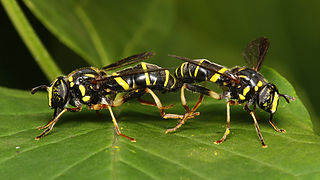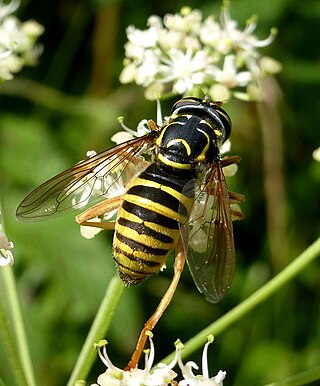
Spilomyia is a genus of hoverflies. Many species in the genus show Batesian mimicry of wasp models, including black and yellow patterns and modified antenna shape.

Spilomyia sayi, the Four-lined Hornet Fly, is a fairly common species of syrphid fly. This species is found from western Canada to northeastern North America. Hoverflies get their names from the ability to remain nearly motionless while in flight. The adults are also known as flower flies for they are commonly found around and on flowers, from which they get both energy-giving nectar and protein-rich pollen. The larvae are known as the short-tailed larvae, suited for moist areas such as rot holes of trees. It is a wasp mimic.

Spilomyia longicornis is a species of syrphid fly, also known as a flower fly or hoverfly, in the family Syrphidae. Although the appearance of S. longicornis is remarkably similar to a vespid wasp, it is a fly and cannot sting. It occurs in North America, east of the Rocky Mountains.
Spilomyia crandalli, Crandall's Hornet Fly, is a rare species of syrphid fly first officially described by Curran in 1951. This species is found in western North America near the Pacific coast. Hoverflies get their names from the ability to remain nearly motionless while in flight. The adults are also known as flower flies for they are commonly found around and on flowers, from which they get both energy-giving nectar and protein-rich pollen. The larvae are known as the short-tailed larvae, suited for moist areas such as rot holes of trees.
Spilomyia annulata is a species of Hoverfly in the family Syrphidae.
Spilomyia maxima is a species of Hoverfly in the family Syrphidae.
Spilomyia sulphurea is a species of Hoverfly in the family Syrphidae.
Spilomyia boschmai is a species of Hoverfly in the family Syrphidae.
Spilomyia chinensis is a species of Hoverfly in the family Syrphidae.
Spilomyia digitata is a species of Hoverfly in the family Syrphidae.

Spilomyia manicata is a species of Hoverfly in the family Syrphidae.

Spilomyia diophthalma is a species of Hoverfly in the family Syrphidae.
Spilomyia graciosa is a species of Hoverfly in the family Syrphidae.
Spilomyia gussakovskii is a species of Hoverfly in the family Syrphidae.
Spilomyia maroccana is a species of Hoverfly in the family Syrphidae.
Spilomyia permagna is a species of Hoverfly in the family Syrphidae.
Spilomyia panfilovi is a species of Hoverfly in the family Syrphidae.
Spilomyia transcaucasica is a species of Hoverfly in the family Syrphidae.
Spilomyia turkmenorum is a species of Hoverfly in the family Syrphidae.
Spilomyia triangulata is a species of Hoverfly in the family Syrphidae.





